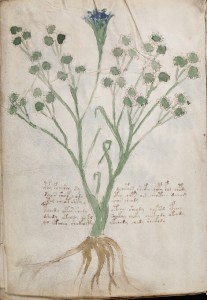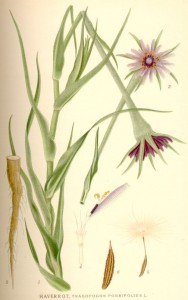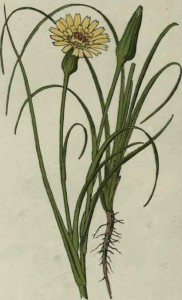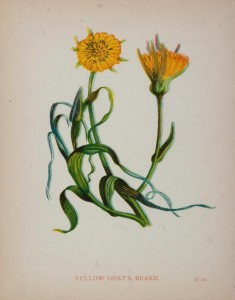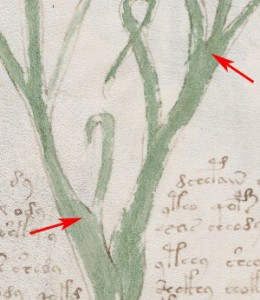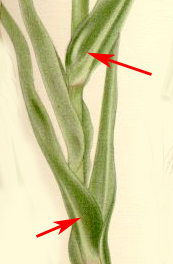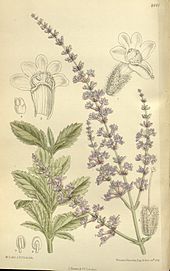Category Archives: The Voynich Large Plants
Large Plants – Folio 65v
Folio 65v shows a large plant illustration stretching from the bottom edge almost to the top and sides. Text is sparse on this page, comprising less than six full lines, and is broken across the stem of the plant (assuming it’s intended to be read line by line).
Most of the plant is painted green with the exception of the inner flower at the top, which is blue. The smaller flower heads (or seed heads) surrounding it have small petals or other structures, that have been left unpainted. The roots are medium brown.
This page follows another Large Plant page and immediately precedes a page full of text with columns of characters down the left side.
Details
Stems: The stems branch regularly, sometimes opposite, sometimes alternate, becoming thinner near the seed heads (I’m calling them “seed heads” to distinguish them from the larger central head that more nearly resembles a flower head).
Leaves: The leaves are long, narrow, sparse, and some curl back toward the ground.
Flower: The top central structure looks like a flower that is partially emerged or perhaps which doesn’t protrude very far even when in full bloom. It is drawn in green and blue. The green area has spikes that may represent a calyx.
Seed Heads: It’s not certain these are seed heads, but many plants with blossoms will have a rounder look to the head and missing or shriveled petals when they go to seed. The centers have been painted green and the small rounded “petals” or other structures remain unpainted.
Side note about the painting technique: Throughout most of VM 408, it appears that the writer and illustrator (we don’t know for certain they are one and the same, but I suspect they are) preferred to write or paint as much as possible before redipping the pen or brush. Thus, the first few dabs are dark and those following become progressively lighter. Here the seed heads top left are darker green, and the rest become lighter as the pigment is depleted. If the illustrator were right-handed and were concerned about not smearing, then starting top left would be practical. It looks like the brush may have been dipped two or three times to fill in all the seed heads.Roots: The roots are fairly numerous and fairly thick, like multiple tap roots, with fine hairs emanating along their length. They are painted medium brown.
Prior Identification
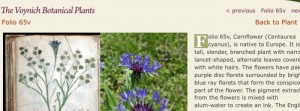 Edith Sherwood has identified this as Centaurea cyanus (cornflower), perhaps because the part that appears to be the flower is painted blue.
Edith Sherwood has identified this as Centaurea cyanus (cornflower), perhaps because the part that appears to be the flower is painted blue.
Other than the color, however, Plant 65v differs from C. cyanus in a number of ways:
- C. cyanus has a rounded, scaly base to the flower head. Plant 65v is more tapered and triangular and lacks the scales.
- C. cyanus spreads out in an umbrella-like fashion from the flower head and each individual petal splits into several pointed tips. Plant 65v barely protrudes and does not have the characteristic parasol shape of the cornflower.
- C. cyanus has more numerous leaves and they do not typically curl like the leaves of 65v. Nearer the base, C. cyanus leaves are larger and have a basal whorl somewhat like a dandelion.
- C. cyanus typically has a single taproot rather than multiple taproots.
- It appears that other plants may be a better match than Centaurea cyanus.
Other Possibilities
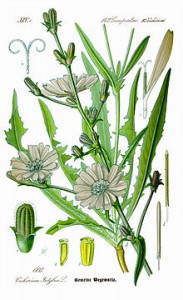 The blue flower and long slender leaves of 65v bring to mind Cichorium intybus (chicory), a salad and forage plant, but chickory leaves are somewhat serrated and they don’t curl in the manner of Plant 65v. C. intybus doesn’t have the scaly round flower head found on C. cyanus, but it does have petals that fan out like a reverse parasol. I don’t think it’s a likely a match for Plant 65v.
The blue flower and long slender leaves of 65v bring to mind Cichorium intybus (chicory), a salad and forage plant, but chickory leaves are somewhat serrated and they don’t curl in the manner of Plant 65v. C. intybus doesn’t have the scaly round flower head found on C. cyanus, but it does have petals that fan out like a reverse parasol. I don’t think it’s a likely a match for Plant 65v.
Scorzonera purpurea or many of the other Scorzoneras might be considered. Many Scorzonera have long narrow leaves that sometimes curl, long calyxes, and one or more tap roots that are sometimes eaten as food. Some Scorzonera have scaly calyxes similar to Centaurea but others (e.g., S. purpurea) have a simple double-layered calyx rather than a complex of scales.
Scorzonera might be a better match than Centaurea, but there are others that come closer.
Tragopogon porrifolius (salsify, oyster plant) is a good candidate for Plant 65v. Various Tragopogon species have blue, purple, pink, or yellow flowers. The calyx of T. porrifolius is triangular and the sepals extend beyond the blossoms, so that the blossoms often have a “tucked in” look. The leaves are long and slender. Tragopogon pratensis (middle) has leaves that curl, as does T. pratensis (right). The long parsnip-like tubers of several species of Tragopogon have a medicinal history and can be eaten boiled or roasted. Sometimes Tragopogon has numerous and surprisingly thick side roots.
But what about all the green and white “puffs” surrounding the blue flower? Later in the year, Tragopogon puts out seed heads that are similar to dandelion puffs, with airy white fluff and a hard center. In some species, the center is white, in others, it is dark. Eventually, the fluff blows away, leaving only the center and a slight fringe of withered sepals. Whether the green and white “knobs” represent seed heads is not clear—it’s something of a stretch. Perhaps this is a representation of the knobs after the seeds have flown or perhaps it’s a different, but related plant.
There is an important detail in Plant 65v that points to Tragopogon as a good candidate. The lower leaves tend to clasp the stem. If you look closely at the Voynich illustration, there are wide spots that look like leaves clasping stems, even if simply and crudely drawn.
Plant 65v may not be Tragopogon, but there’s a good chance that it is and, in terms of flower head, leaf arrangement, stem, and root characteristics, it’s a better candidate than Centaurea cyanus.
Posted by J. Petersen
Large Plants – Folio 65r
Large Plants – Folio 57r
Large Plants – Folio 56v
Large Plants – Folio 56r
Large Plants – Folio 55v
Large Plants – Folio 55r
Voynich Large Plants – Folio 54v
Description
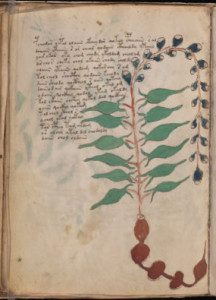 Plant 54v stretches from bottom to top on the right half of the page, with a block of text added to the left very close to the edge of the plant, almost overlapping the leaves and flower spike.
Plant 54v stretches from bottom to top on the right half of the page, with a block of text added to the left very close to the edge of the plant, almost overlapping the leaves and flower spike.
The stem is slender and reddish brown. The medium-green leaves are opposite and hastate (they look like fish), with short reddish petioles.
The root has a bead-like string of tubers painted reddish-brown and the top of the stem has a long drooping flower spike with buds, seed capsules or berries with a spot or perhaps a reflection? at the end.
The buds or “berries” are painted blue and are slightly oval and droop down toward the bottom of the page. Whether the droop is there to fit the plant on the page or if this is the way the plant grows is difficult to determine from the drawing alone. In some herbal illustrations, a tall plant is represented by running it along the top of the page or by creating a “break” in the stem to show that it would continue upwards if not broken. The VMS plant drops down along the edge.
Prior Identifications
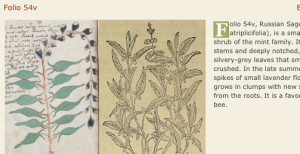 Edith Sherwood has identified this plant as Russian sage (Perovskia atriplicifolia), a south-central Asian plant loosely related to what we normally call sage (Salvia). I hate to be blunt, but I can’t see any commonalities between Plant 54v and Russian sage, either in the shapes of individual parts of the plant or in growth habit.
Edith Sherwood has identified this plant as Russian sage (Perovskia atriplicifolia), a south-central Asian plant loosely related to what we normally call sage (Salvia). I hate to be blunt, but I can’t see any commonalities between Plant 54v and Russian sage, either in the shapes of individual parts of the plant or in growth habit.
P. atriplicifolia has tall slender stems and small, deeply lacerated leaves that are quite feathery (not fish-like at all). The stems are whitish green, somewhat downy, and the flowers a soft violet-blue. Russian sage is a handsome bushy plant with a tap root, whereas Plant 54v has leaves that grow up along the stem, rather than being bushy toward the base like P. atriplicifolia.
The leaves of Russian sage are distinctly different from the sorrel-like leaves of Plant 54v, as can be seen from the photo below.
The only apparent similarity is in the spike of bluish buds or flowers or berries. Russian sage doesn’t have berries, but it does have bluish buds. And, like the Voynich plant, the spikes are quite long but… Plant 54v has a single spike, whereas Russian sage typically branches, so even the spikes differ in a number of ways.
The Fishy Leaves
The illustration below shows the elliptical, sometimes deeply lacerated leaves of Russian sage compared to the VMS plant and, on the right, two plants with fish-like leaves.
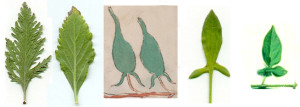
Russian sage (left), VMS plant leaves (center). Note that the Russian sage leaves are elliptical and many of them deeply lacerated. The hastate fish-like leaves of R. acetosella (second right) and Solanum (right) are more similar to the Voynich plant than to the ones on the left. Both are common plants. (Leaf pics courtesy of Missouri Plants).
Other Possible Identifications
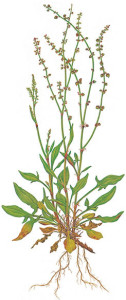 Based on the shape of the leaves and stems, the two most obvious candidates for Plant 54v are some form of sorrel (e.g., Rumex acetosella) or Solanum (possibly Solanum dulcamara), a form of nightshade. Both are well represented in herbal manuscripts and both have long fruiting heads and hastate leaves. Sorrel is considered edible and medicinal and Solanum, which has distinctive berries, has many traditional medicinal associations. Note in the picture to the right that sorrel leaves are generally near to the ground, but I have seen varieties with leaves growing up along the stem, as well.
Based on the shape of the leaves and stems, the two most obvious candidates for Plant 54v are some form of sorrel (e.g., Rumex acetosella) or Solanum (possibly Solanum dulcamara), a form of nightshade. Both are well represented in herbal manuscripts and both have long fruiting heads and hastate leaves. Sorrel is considered edible and medicinal and Solanum, which has distinctive berries, has many traditional medicinal associations. Note in the picture to the right that sorrel leaves are generally near to the ground, but I have seen varieties with leaves growing up along the stem, as well.
The problem with making a definite ID (or choosing between sorrel or nightshade) is that both have leaves that are arranged alternately, and they don’t have distinctively knobby roots. I don’t think these differences are mistakes on the part of the VMS illustrator, I think whoever drew the plants was making an effort to express details accurately even if they are sometimes symbolically expressed, but what does that leave in terms of alternate IDs?
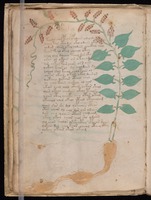 First I should mention that Plant 17v (left) has similar characteristics to 54v—opposite hastate leaves, a long fruiting spike, and a long bead-like root. It’s drawn larger than 54v and has a tendril at the end of the spike, perhaps indicating that it’s a viny plant.
First I should mention that Plant 17v (left) has similar characteristics to 54v—opposite hastate leaves, a long fruiting spike, and a long bead-like root. It’s drawn larger than 54v and has a tendril at the end of the spike, perhaps indicating that it’s a viny plant.
Sticky sage (Salvia glutinosa) might qualify for Plant 54v—it has somewhat hastate opposite leaves, red stems, and a long fruiting spike—but the VMS plant has smooth leaf margins, while sticky sage leaves are quite deeply toothed.
Looking Farther East
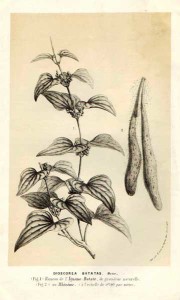 Cinnamon vine (also known as Chinese potato or Japanese yam) is a better candidate than any of the previous plants. It has hastate opposite leaves (moreso when the plant is dried), distinctive red stems, fruiting spikes and a lumpy tuber that can reach three feet in length. In fact, cinnamon vine (Dioscorea batatas) qualifies quite well for Plant 17v except that the hastate leaves aren’t as pointy and narrow as 17v.
Cinnamon vine (also known as Chinese potato or Japanese yam) is a better candidate than any of the previous plants. It has hastate opposite leaves (moreso when the plant is dried), distinctive red stems, fruiting spikes and a lumpy tuber that can reach three feet in length. In fact, cinnamon vine (Dioscorea batatas) qualifies quite well for Plant 17v except that the hastate leaves aren’t as pointy and narrow as 17v.
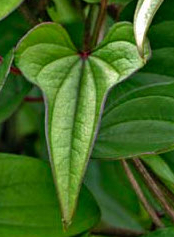 Cinnamon vine originates in Central and S.E. Asia, so it’s hard to know when it was introduced to the western world, but there is at least one old herbal illustration notated in Greek that resembles cinnamon vine, so perhaps it, or one of its relatives, came west with traveling merchants. It is an important food crop, known to the west as the yam, and is now known throughout the world.
Cinnamon vine originates in Central and S.E. Asia, so it’s hard to know when it was introduced to the western world, but there is at least one old herbal illustration notated in Greek that resembles cinnamon vine, so perhaps it, or one of its relatives, came west with traveling merchants. It is an important food crop, known to the west as the yam, and is now known throughout the world.
Home Again
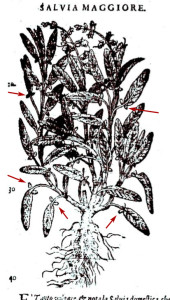 There is a plant native to the Mediterranean area with opposite hastate leaves, that has a thick root (though not as knobby as VMS 54v).
There is a plant native to the Mediterranean area with opposite hastate leaves, that has a thick root (though not as knobby as VMS 54v).
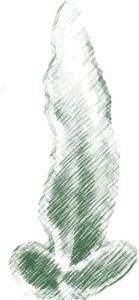 Greek sage (Salvia triloba), also known as Greek oregano, has distinctive downy fish-like leaves with smooth margins, and violet-blue flowers on long spikes. Like most sage plants, it does tend to branch, however, but should perhaps be considered as a candidate for 54v.
Greek sage (Salvia triloba), also known as Greek oregano, has distinctive downy fish-like leaves with smooth margins, and violet-blue flowers on long spikes. Like most sage plants, it does tend to branch, however, but should perhaps be considered as a candidate for 54v.
It’s possible that the plant labeled Salvia maior or Salvia maggiore in many of the old herbals (left) is Greek sage, as a number of them show the distinctive fish-like leaves of this species of Salvia.
What Else is There?
We’re not out of options yet. There’s another plant that deserves consideration. In fact, it may even resemble 17v more than 54v, though it’s similar to both and worth discussing here.
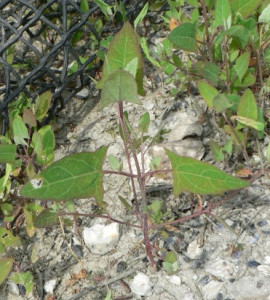
Atriplex prostata with reddish stems and opposite, hastate leaves courtesy of Georges Laroche, Fleurs des Champs
Orache or “fat hen” is a common plant in Europe and temperate North America that adapts well to disturbed locations. When dried (as a herbarium specimen), the leaves are distinctively hastate. The leaves are sometimes alternate, sometimes opposite, attached to reddish-brown stems. Many species of Atriplex have longish fruiting spikes. It’s an adaptable plant, sometimes bushy, sometimes spindly, depending on the species and the environment. It often grows in the same locations as Rumex plants.
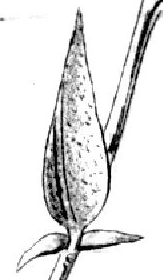 Most Atriplex plants have broadly hastate leaves, but there are some with very narrow leaf-ends, similar to VM 54v. The challenge is to find a species that has both narrow leaf-ends and opposite leaves on the same plant. We also have to consider that there may be species that have disappeared over the last 600 years since the VMS plants were drawn.
Most Atriplex plants have broadly hastate leaves, but there are some with very narrow leaf-ends, similar to VM 54v. The challenge is to find a species that has both narrow leaf-ends and opposite leaves on the same plant. We also have to consider that there may be species that have disappeared over the last 600 years since the VMS plants were drawn.
Summary
As with many VMS plant IDs, it’s difficult to narrow it down to one plant, but sometimes it’s possible to narrow it down to two or three likely candidates. If the VMS plant is very literal, then a narrow-leaved spindly variety of Atriplex might be the best choice in terms of hitting all the bases. If it’s a simplification (showing only one branch rather than many), it might be Solanum dulcamara or Greek Sage. If the opposite leaves are accurate, it’s probably not Rumex acetosella, even though it resembles sorrel in many ways, but if the leaves are drawn opposite for convenience or for visual effect, rather than for accuracy, perhaps Rumex is a possibility.
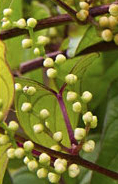 And then there’s Cinnamon vine—reddish stems, knobby flowers and darker, knobby seeds, big lumpy tubers, and opposite hastate leaves—other than having broader leaves, it resembles Plant 54v in most respects. If Dioscorea were known to the VMS illustrator in the 15th century, it’s perhaps the best choice.
And then there’s Cinnamon vine—reddish stems, knobby flowers and darker, knobby seeds, big lumpy tubers, and opposite hastate leaves—other than having broader leaves, it resembles Plant 54v in most respects. If Dioscorea were known to the VMS illustrator in the 15th century, it’s perhaps the best choice.
I’m not staking my hand on a specific ID for this plant, at least not yet. I don’t think there’s enough information to narrow it down to just one, but I think Russian sage is out of the running.
J.K. Petersen
© Copyright 2013 J.K. Petersen, All Rights Reserved

